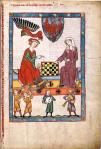Tags
140 lyric poets, Anthology of songs, Arany Zoltang, Codex Manesse, illuminated manuscript, Minnesang, Minnesingers, Troubadours & Trouvères, University of Heidelberg, Walther von der Vogelweide
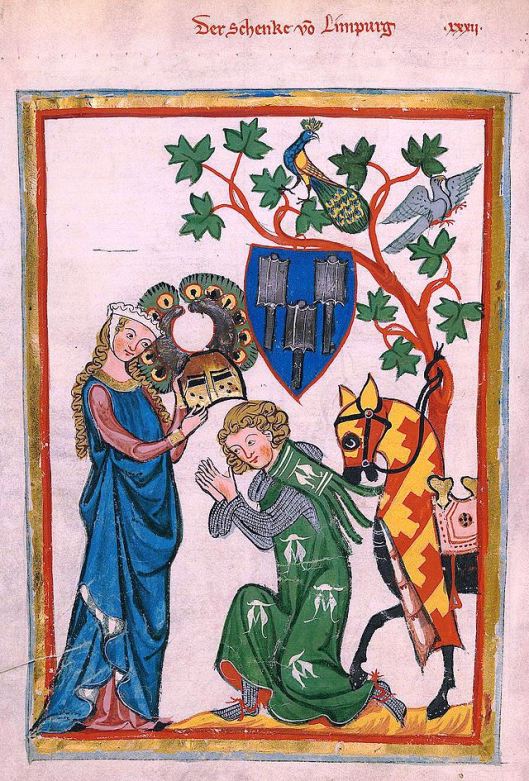
Der Schenke von Limburg, fol. 82v (Photo credit: Wikimedia Commons)
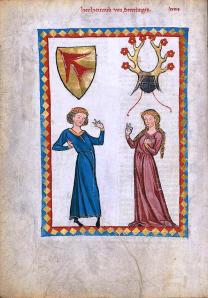
Herr Heinrich von Stretlingen, fol. 70v
The Minnesang
troubadour trouvère Minnesanger illuminated manuscript (handschrift)Medieval art is always new. It belongs to a collective childhood eager to chronicle every joyous moment of its journey into the future, despite calamities. The plague ended the golden era of the Provençal troubadour (langue d’oc), the trouvères (langue d’oïl) of northern France, and the Minnesingers[i] of German-language lands.
The word “trouvère” applies to all three groups. They were finding (“trouver”), or creating, and they were preserving. The Codex Manesse is a comprehensive collection of German-language songs constituting a most precious and informative testimonial. The codex is an anthology of texts with portraits, but many of its folios are illuminated manuscripts that have survived the test of time. It could well be “the most beautifully illumined German manuscript in centuries.” (See Codex Manesse – Wikipedia, the free encyclopedia.)
Source
collection of Rüdiger II Manesse and his son Zürich 14th centuryThe images featured above and below adorn the Codex Manesse, an extensive song book compiled and illumined “between c. 1304 when the main part was completed, and c. 1340.” It is “the most important single source of medieval Minnesang poetry [love poetry].” (See Codex Manesse – Wikipedia, the free encyclopedia.)
The Codex Manesse‘s main source was the collection of patrician Rüdiger II Manesse and his son. It was produced in Zürich, and was written in Middle High German. (See Codex Manesse – Wikipedia, the free encyclopedia.)
Contributors
Emperor (Kaiser) King (König) Count (Graf) Knight HerrThe lyric poets who contributed songs to the celebrated Codex Manesse are listed on the website of Cod. Pal. germ. 848 and under the Codex’s Wikipedia entry Codex Manesse. Many of its contributors were aristocrats and among these dignitaries are Kaiser [Emperor] Heinrich (fol. 6r), König (King) Konrad der Junge (fol. 7r), König Tyro von Schötten (fol. 8r), König Wenzel von Böhmen (fol. 10r), Herzog Heinrich von Breslau (fol. 11v). Earlier folios feature the more aristocratic lyric poets. (See Codex Manesse.)
Details
The Codex contains 137 miniatures that are a series of “portraits” depicting singers who had contributed a song to the Codex. It consists of 6,000 verses from 140 poets totalling 426 parchment leaves, including 140 blank as well as partially blank pages. There were four illuminators. It lacks musical notation. The Codex Manesse is housed at the University of Heidelberg. (See: http://digi.ub.uni-heidelberg.de/diglit/cpg848; http://www.ub.uni-heidelberg.de/Englisch/)
Walther von der Vogelweide
Folio 124r is a portrait of the most famous Minnesinger, Walther von der Vogelweide (c. 1170 – c. 1230). Walther’s main theme was love, but he introduced greater realism in his depiction of love and other topics: political, moral, or religious.[ii]
It appears Walther was born in the Tirol, but learned to sing and speak in Austria. “Ze ôsterriche lernt ich singen unde sagen [sic].” According to Wikipedia, Walther was probably knighted and “was initially a retainer in a wealthy, noble household and had rooms.” (See Walther von der Vogelweide – Wikipedia, the free encyclopedia.)
In about 1224, he settled on the fief given to him by Frederick II, in Würzburg. Walther died on his fief.[iii]
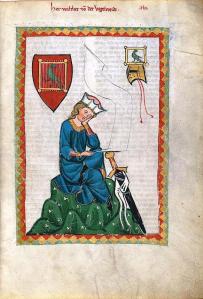
Walther von der Vogelweide, fol. 124r
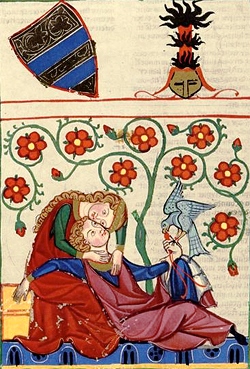
Konrad von Altstetten, fol. 249v
Sources and Resources
- Codex Manesse, Große Heidelberger Liederhandschrift
- Cod. Pal. germ. 848
- Zürich, ca. 1300 bis ca. 1340
- http://digi.ub.uni-heidelberg.de/diglit/cpg848 ♥
- http://www.ub.uni-heidelberg.de/Englisch/
- See the List of such codices.
- Photo credit: the University of Heidelberg (most)
My kindest regards to all of you.
____________________[i] “minnesinger.” Encyclopædia Britannica. Encyclopædia Britannica Online. Encyclopædia Britannica Inc., 2014. Web. 21 Sep. 2014. <http://www.britannica.com/EBchecked/topic/384329/minnesinger>.
[ii] “Walther von der Vogelweide.” Encyclopædia Britannica. Encyclopædia Britannica Online. Encyclopædia Britannica Inc., 2014. Web. 20 Sep. 2014. <http://www.britannica.com/EBchecked/topic/635145/Walther-von-der-Vogelweide>.
[iii] Ibid.
Arany Zoltán



